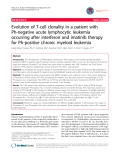
Acute and chronic myeloid leukemia
Xem 1-1 trên 1 kết quả Acute and chronic myeloid leukemia
-
Tuyển tập báo cáo các nghiên cứu khoa học quốc tế ngành y học dành cho các bạn tham khảo đề tài:Evolution of T-cell clonality in a patient with Ph-negative acute lymphocytic leukemia occurring after interferon and imatinib therapy for Ph-positive chronic myeloid leukemia
 7p
7p  toshiba24
toshiba24
 06-12-2011
06-12-2011
 51
51
 3
3
 Download
Download
CHỦ ĐỀ BẠN MUỐN TÌM
TOP DOWNLOAD













